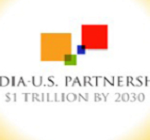Washington D.C, 14 September 2014: India’s prime minister, Narendra Modi, will make a landmark visit to the U.S. in September 2014. Anticipating a renewed partnership between the two countries, Gateway House, an Indian foreign policy think tank, launched a research paper ahead of the prime minister’s visit titled The India-U.S. Partnership: $1 Trillion by 2030 on 14 September 2014 at the Center for American Progress in Washington D.C.
To elevate the bilateral from $120 billion in 2013 to $1 trillion in 2030, the research paper advocates a different path for the India-U.S. bilateral from all others – one based on the hockey-stick curve more typical of tech start-ups, one that will bring India into the group of the three other countries outside of the G7 which have a deep economic relationship with the U.S.: Israel, Mexico and South Korea.
Technology, then as now, presents the springboard for the future of a vigorous India-U.S. partnership. The paper identifies four positions that India must pursue, and four that the U.S. must pursue for the success of the engagement.
What India needs to do:
- In order to tackle India’s development challenges, it is necessary to create a “surge” – i.e. rapid and intense deployment of talented individuals and technical experts to address critical and immediate challenges – in areas such as infrastructure, healthcare, energy and agriculture. A surge provides an opportunity to invite companies and experts from the U.S. to begin working on critical areas.
- Leading and innovating new technologies can create millions of new jobs and opportunities in India. Towards this, India needs to build a “Silicon Swadesh” – a robust entrepreneurial ecosystem, modelled on Silicon Valley, to support home-grown innovation and entrepreneurship across several Indian cities.
- India needs to build a ramp for poverty alleviation i.e. a ramp which would enable the 42% of Indians that live under the World Bank poverty line of $1.25 a day to access the services of NGOs, social entrepreneurs and microfinance organisations. These organisations are able to identify problems as well as scale solutions, but they are unable to build sustainable systems and expertise to achieve a lasting impact. Entrepreneurial and non-profit models from the U.S. can be of assistance here.
- The country needs to take advantage of next generation technologies for which it is well suited, such as synthetic biology, 3D printing, mobile, social and big data, to create an industrial base in India from which products and services can be sold and jobs created. The U.S. is a pioneer in many of these technologies, and a fruitful collaboration between the two countries would involve mainly research and sales.
What the U.S. needs to do:
- Indian Americans have contributed significantly to the entrepreneurial, small business and healthcare sectors in the U.S. – Indian American co-founders form nearly 33% of Silicon Valley start-ups and account for about 7% of American physicians. India can continue to feed this pipeline of skilled professionals in the U.S.
- Companies in the U.S. have struggled with budget limitations caused by global competition and the global financial crisis. Indian companies have experience in low-cost innovation, constant process improvement and frugal budgeting and seeing applications – much can be learned from them about innovation and scale.
- An estimated 100 million Indians who study and work abroad have family and friends in the U.S. and maintain a connection to the U.S. throughout their lives. The U.S. can leverage this customer base in the areas of education, tourism and luxury brands.
- The number of development entrepreneurs and innovators in the U.S. is increasing – their inventions are technologically cutting edge, and they are committed to making a difference. They are keen to collaborate with Indian partners on research, innovation, experimentation to reach a potential customer base of nearly 5 billion Indians for development-related products, brands and services.
The complete executive summary of the paper is available on our website www.gatewayhouse.in. The paper will be launched in India on 17 November 2014, alongside the India-U.S. Technology Summit in New Delhi, India.
For more information on the paper or interview requests, please contact Reetika Joshi at joshi.reetika@gatewayhouse.in or +91 88793 61671.


